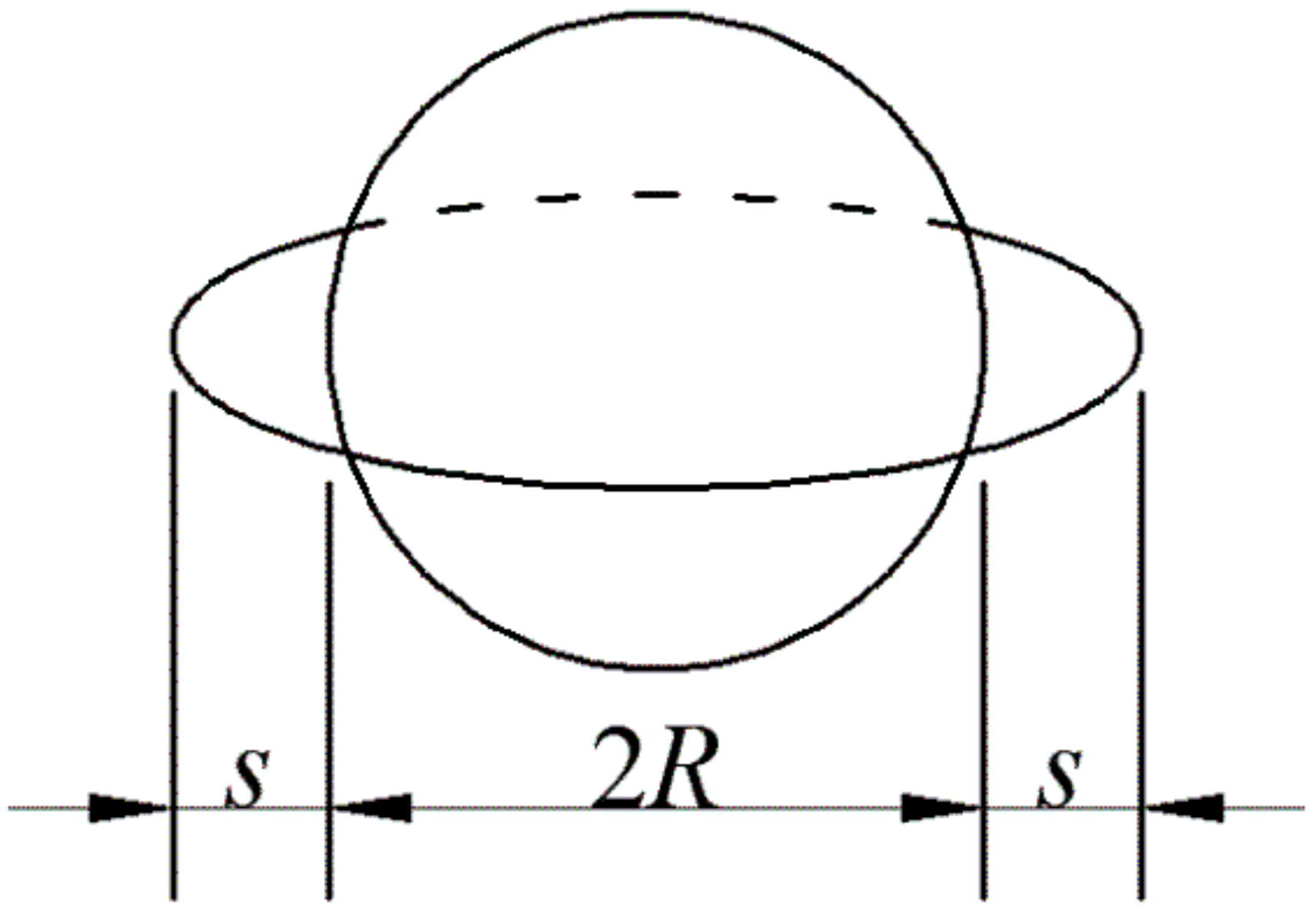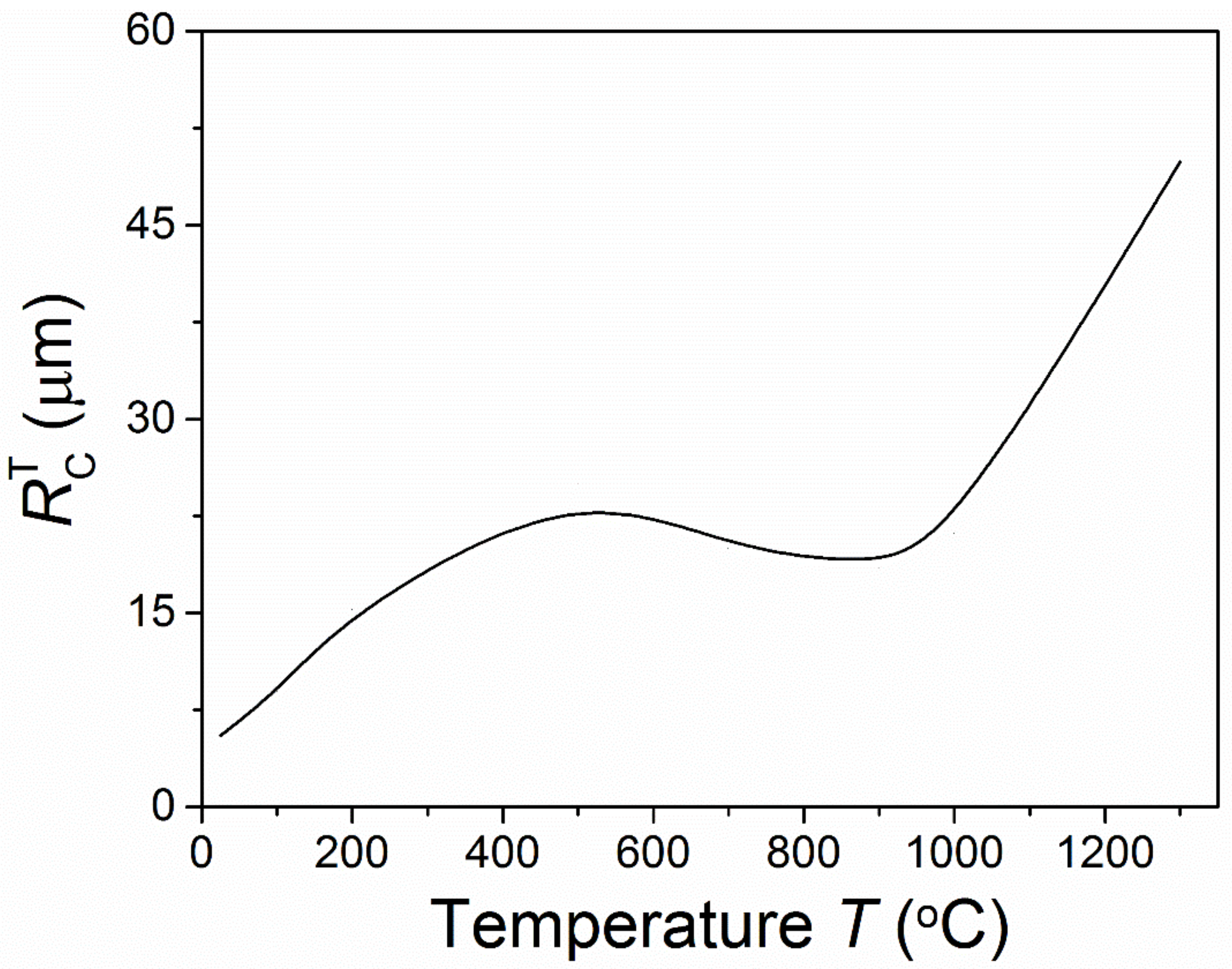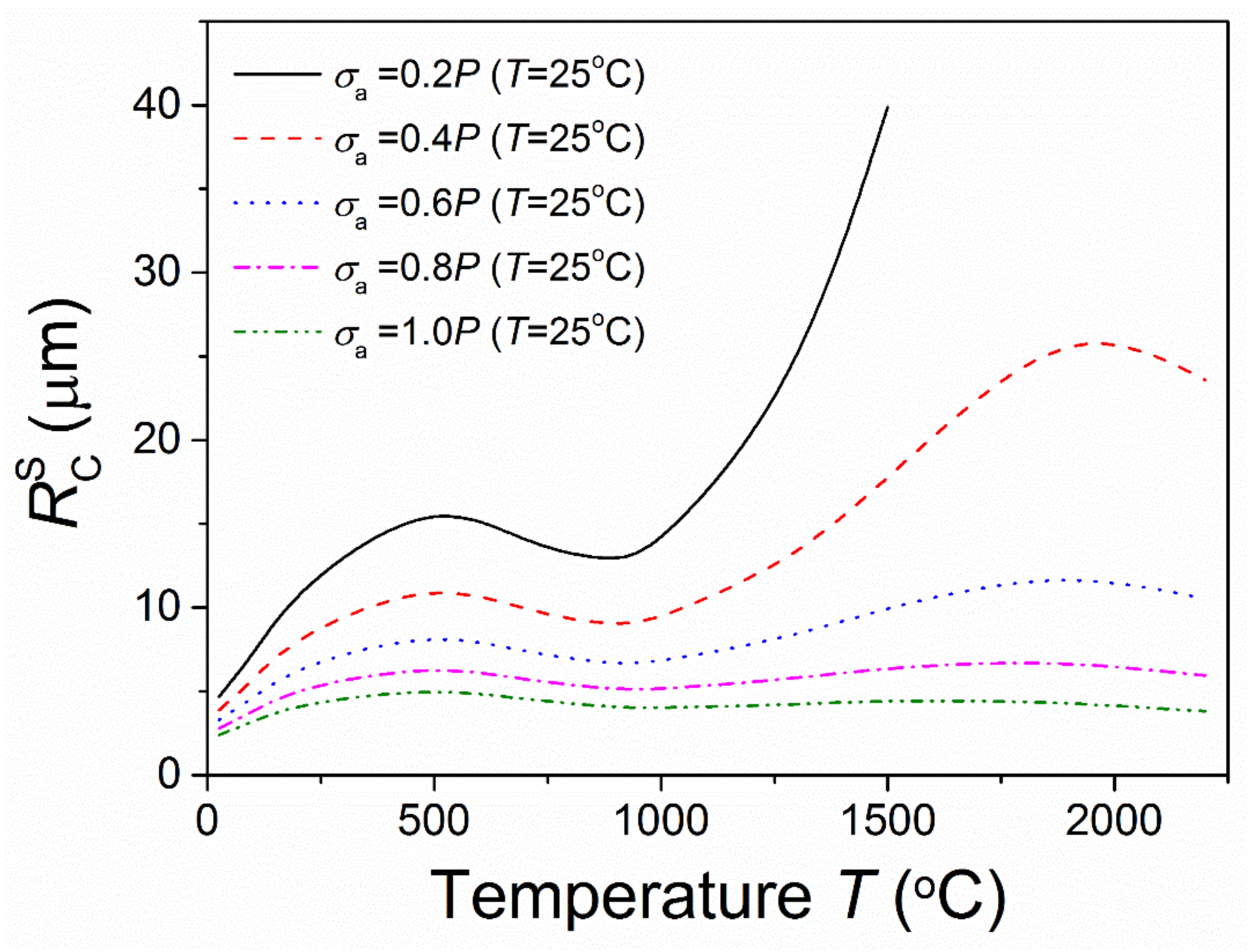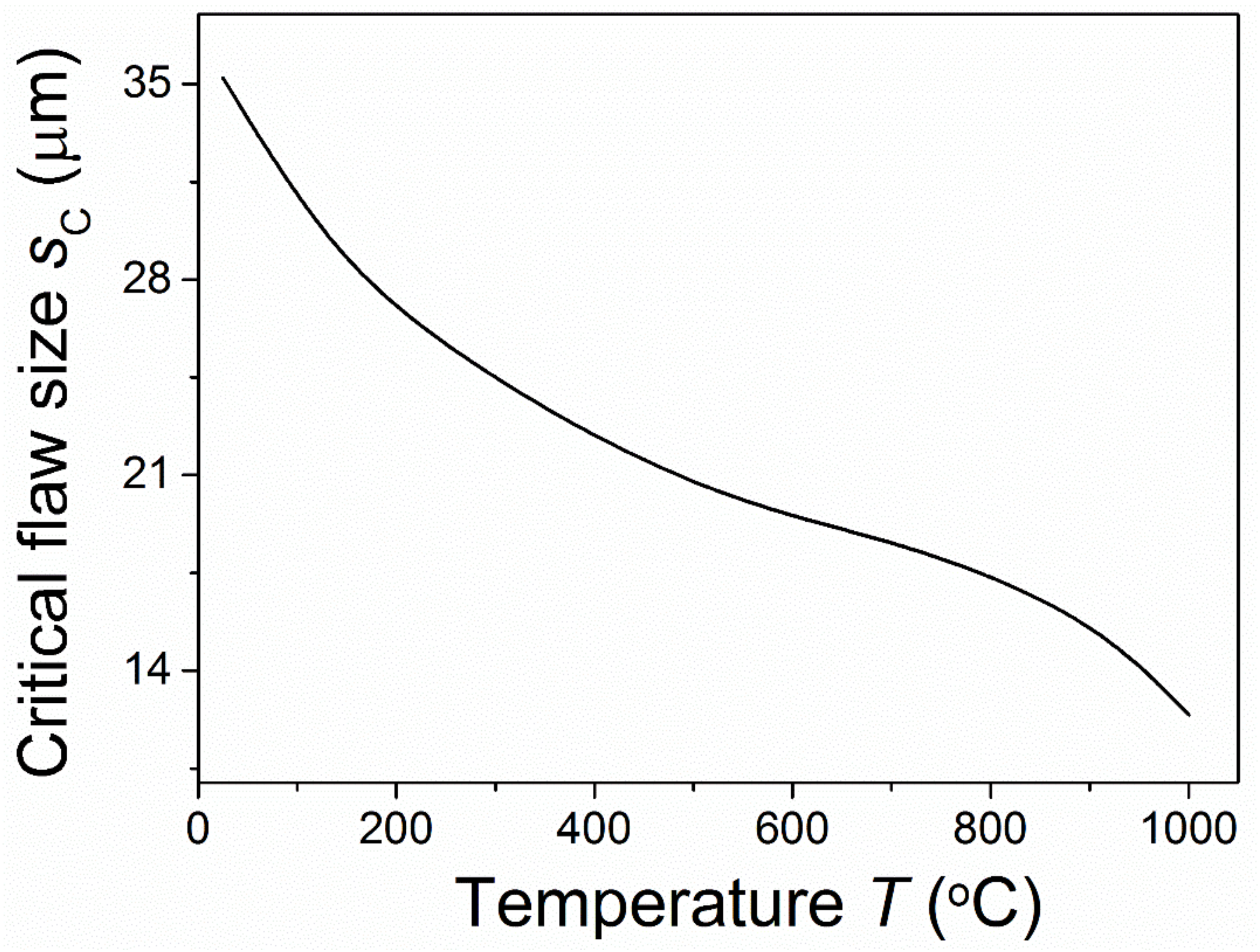Stress-Induced Microcracking and Fracture Characterization for Ultra-High-Temperature Ceramic Matrix Composites at High Temperatures
Abstract
:1. Introduction
2. Temperature-Dependent Models
3. Results and Discussion
4. Conclusions
Author Contributions
Funding
Data Availability Statement
Conflicts of Interest
List of Notations
| Notation | Description |
| R | Particle radius |
| s | Flaw size |
| P | Residual stress |
| αm,αp | Thermal expansion coefficients of the matrix and particle |
| Em,Ep | Young’s modulus of the matrix and particle |
| νm,νp | Poisson’s ratio of the matrix and particle |
| Ts | Sintering temperature |
| Tr | Room temperature |
| Tm | Melting temperature |
| Radial components of residual stress | |
| Tangential components of residual stress | |
| Stress intensity factor at the tip of the flaw due to residual stress | |
| P(T) | Temperature-dependent residual stress |
| T | Current temperature |
| αm(T), αp(T) | Temperature-dependent thermal expansion coefficients of the matrix and particle |
| Em(T), Ep(T) | Temperature-dependent Young’s modulus of the matrix and particle |
| νm(T), νp(T) | Temperature-dependent Poisson’s ratio of the matrix and particle |
| Temperature-dependent stress intensity factor at the tip of the flaw due to residual stress | |
| Temperature-dependent critical inclusion size for spontaneous microcracking | |
| Temperature-dependent critical stress intensity factor for a local failure | |
| Temperature-dependent critical stress intensity factor for the extension of a critical flaw | |
| Constant | |
| Temperature-dependent fracture toughness | |
| External stress | |
| Stress intensity factor at the tip of the flaw due to applied stress | |
| Temperature-dependent stress intensity factor at the tip of the flaw due to both residual stress and applied stress | |
| Temperature-dependent critical inclusion size for microcracking under the applications of external stress and residual stress | |
| Temperature-dependent fracture strength | |
| A | Constant |
References
- Kaufman, L.; Clougherty, E.V. Investigation of Boride Compounds for High Temperature Applications; Part XXXVII; ManLabs Inc.: Cambridge, MA, USA, 1963. [Google Scholar]
- Opeka, M.M.; Talmy, I.G.; Wuchina, E.J.; Zaykoski, J.A.; Causey, S.J. Mechanical, thermal, and oxidation properties of refractory hafnium and zirconium compounds. J. Eur. Ceram. Soc. 1999, 19, 2405–2414. [Google Scholar] [CrossRef] [Green Version]
- Gasch, M.; Ellerby, D.; Irby, E.; Beckman, S.; Gusman, M.; Johnson, S. Processing, properties and arc jet oxidation of hafnium diboride/silicon carbide ultra high temperature ceramics. J. Mater. Sci. 2004, 39, 5925–5937. [Google Scholar] [CrossRef]
- Fang, D.N.; Li, W.G.; Cheng, T.B.; Qu, Z.L.; Chen, Y.F.; Wang, R.Z.; Ai, S.G. Review on mechanics of ultra-high-temperature materials. Acta Mech. Sin. 2021, 37, 1347–1370. [Google Scholar] [CrossRef]
- Zhu, S.M.; Fahrenholtz, W.G.; Hilmas, G.E. Influence of silicon carbide particle size on the microstructure and mechanical properties of zirconium diboride–silicon carbide ceramics. J. Eur. Ceram. Soc. 2007, 27, 2077–2083. [Google Scholar] [CrossRef]
- Watts, J.; Hilmas, G.; Fahrenholtz, W.G. Mechanical characterization of ZrB2-SiC composites with varying SiC particle sizes. J. Am. Ceram. Soc. 2011, 94, 4410–4418. [Google Scholar] [CrossRef]
- Xu, X.H.; Xu, B.S.; Hong, C.Q.; Hui, D. Effect of pyrolytic carbon interface thickness on microstructure and mechanical properties of lightweight zirconium boride modified carbon-bonded carbon fiber composites. Compos. Part B-Eng. 2016, 96, 305–311. [Google Scholar] [CrossRef] [Green Version]
- Grigoriev, O.N.; Galanov, B.A.; Kotenko, V.A.; Ivanov, S.M.; Koroteev, A.V.; Brodnikovsky, N.P. Mechanical properties of ZrB2–SiC(ZrSi2) ceramics. J. Eur. Ceram. Soc. 2010, 30, 2173–2181. [Google Scholar] [CrossRef]
- Davidge, R.W.; Green, T.J. The strength of two-phase ceramic/glass materials. J. Mater. Sci. 1968, 3, 629–634. [Google Scholar] [CrossRef]
- Green, D.J. Stress-induced microcracking at second-phase inclusions. J. Am. Ceram. Soc. 1981, 64, 138–141. [Google Scholar] [CrossRef]
- Krstic, V.D.; Vlajic, M.D. Conditions for spontaneous cracking due to the presence of thermo-elastic stresses. Acta Metall. 1983, 31, 139–144. [Google Scholar] [CrossRef]
- Wang, R.Z.; Li, W.G.; Ji, B.H.; Fang, D.N. Fracture strength of the particulate-reinforced ultra-high temperature ceramics based on a temperature dependent fracture toughness model. J. Mech. Phys. Solids 2017, 107, 365–378. [Google Scholar] [CrossRef]
- Wang, R.Z.; Li, D.Y.; Xing, A.; Jia, B.; Li, W.G. Temperature dependent fracture strength model for the laminated ZrB2 based composites. Compos. Struct. 2017, 162, 39–46. [Google Scholar] [CrossRef]
- Wang, R.Z.; Li, W.G. Characterization models for thermal shock resistance and fracture strength of ultra-high temperature ceramics at high temperatures. Theor. Appl. Fract. Mech. 2017, 90, 1–13. [Google Scholar] [CrossRef]
- Wang, R.Z.; Li, D.Y.; Wang, X.R.; Li, W.G. A novel and convenient temperature dependent fracture strength model for the laminated ultra-high temperature ceramic composites. J. Alloys Compd. 2019, 771, 9–14. [Google Scholar] [CrossRef]
- Wang, R.Z.; Wang, S.; Li, D.Y.; Xing, A.; Zhang, J.; Li, W.G. Theoretical characterization of the temperature dependence of the contact mechanical properties of the particulate-reinforced ultra-high temperature ceramic matrix composites in Hertzian contact. Int. J. Solids Struct. 2021, 214–215, 35–44. [Google Scholar] [CrossRef]
- Selsing, J. Internal Stresses in Ceramics. J. Am. Ceram. Soc. 1961, 44, 419–420. [Google Scholar] [CrossRef]
- Neuman, E.W.; Hilmas, G.E.; Fahrenholtz, W.G. Mechanical behavior of zirconium diboride–silicon carbide ceramics at elevated temperature in air. J. Eur. Ceram. Soc. 2013, 33, 2889–2899. [Google Scholar] [CrossRef]
- Neuman, E.W.; Hilmas, G.E.; Fahrenholtz, W.G. Mechanical behavior of zirconium diboride–silicon carbide–boron carbide ceramics up to 2200 °C. J. Eur. Ceram. Soc. 2015, 35, 463–476. [Google Scholar] [CrossRef]
- Snead, L.L.; Nozawa, T.; Katoh, Y.; Byun, T.S.; Kondo, S.; Petti, D.A. Handbook of SiC properties for fuel performance modelling. J. Nucl. Mater. 2007, 371, 329–377. [Google Scholar] [CrossRef]
- Chamberlain, A.L.; Fahrenholtz, W.G.; Hilmas, G.E.; Ellerby, D.T. High-strength zirconium diboride-based ceramics. J. Am. Ceram. Soc. 2004, 87, 1170–1172. [Google Scholar] [CrossRef]
- Zhang, G.J.; Deng, Z.Y.; Kondo, N.; Yang, J.F.; Ohji, T. Reactive hot pressing of ZrB2-SiC composites. J. Am. Ceram. Soc. 2000, 83, 2330–2332. [Google Scholar] [CrossRef]
- Ye, D.L. Practical Handbook of Thermodynamic Data for Inorganic Compounds; Metallurgical Industry Publishing House: Beijing, China, 1981. [Google Scholar]
- Ulrich, S.; Ehrhardt, H.; Schwan, J.; Samlenski, R.; Brenn, R. Subplantation effect in magnetron sputtered superhard boron carbide thin films. Diamond Relat. Mater. 1998, 7, 835–838. [Google Scholar] [CrossRef]
- Zou, J.; Zhang, G.J.; Vleugels, J.; Van der Biest, O. High temperature strength of hot pressed ZrB2–20 vol% SiC ceramics based on ZrB2 starting powders prepared by different carbo/boro-thermal reduction routes. J. Eur. Ceram. Soc. 2013, 33, 1609–1614. [Google Scholar] [CrossRef]






| Material Parameters | Values and Expressions |
|---|---|
| νm | 0.25 |
| νp | 0.19 |
| Ts (°C) | 1950 |
| Tm (°C) | 3049.85 |
| T0 (°C) | 25 |
| γ(T0) (J⋅m−2) | 12.76 |
| Cp(T) (cal/mol) | 15.34 + 2.25 × 10−3 (T + 273.15) − 3.96 × 105 (T + 273.15)−2 |
| αm(T) (°C−1) | (2.33 + 0.006 × (T + 273.15) − 0.2 × 10−5 × (T + 273.15)2) × 10−6 |
| αp(T) (°C−1) | (−1.8276 + 0.0178(T + 273.15) − 1.5544 × 10−5(T + 273.15)2 + 4.5246 × 10−9 (T + 273.15)3) × 10−6(0 °C ≤ T < 1000 °C) |
| αp(T) (°C−1) | 5.0 × 10−6(T ≥ 1000 °C) |
| Em(T) (GPa) | |
| Ep(T) (GPa) |
Publisher’s Note: MDPI stays neutral with regard to jurisdictional claims in published maps and institutional affiliations. |
© 2022 by the authors. Licensee MDPI, Basel, Switzerland. This article is an open access article distributed under the terms and conditions of the Creative Commons Attribution (CC BY) license (https://creativecommons.org/licenses/by/4.0/).
Share and Cite
Gu, M.; Wu, C.; Chen, X.; Wan, Y.; Liu, Y.; Zhou, S.; Cai, H.; Jia, B.; Wang, R.; Li, W. Stress-Induced Microcracking and Fracture Characterization for Ultra-High-Temperature Ceramic Matrix Composites at High Temperatures. Materials 2022, 15, 7074. https://doi.org/10.3390/ma15207074
Gu M, Wu C, Chen X, Wan Y, Liu Y, Zhou S, Cai H, Jia B, Wang R, Li W. Stress-Induced Microcracking and Fracture Characterization for Ultra-High-Temperature Ceramic Matrix Composites at High Temperatures. Materials. 2022; 15(20):7074. https://doi.org/10.3390/ma15207074
Chicago/Turabian StyleGu, Mingyu, Chunyan Wu, Xingyu Chen, Yu Wan, Yumeng Liu, Shan Zhou, Hongwei Cai, Bi Jia, Ruzhuan Wang, and Weiguo Li. 2022. "Stress-Induced Microcracking and Fracture Characterization for Ultra-High-Temperature Ceramic Matrix Composites at High Temperatures" Materials 15, no. 20: 7074. https://doi.org/10.3390/ma15207074




